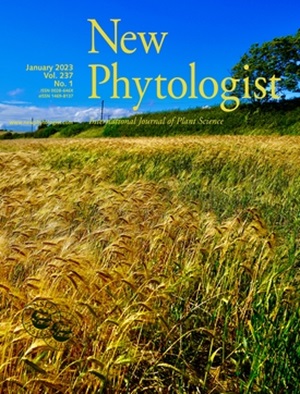Genomic evidence unveils the genetic architecture and evolution of the S-locus controlling heterostyly in Rubiaceae
IF 8.1
1区 生物学
Q1 PLANT SCIENCES
引用次数: 0
Abstract
- The S-locus supergene controlling heterostyly has multiple angiosperm origins and is characterized by convergent evolution in form and function. The genetic architecture of floral polymorphism has been studied in several unrelated families, but not Rubiaceae, which has the largest number of heterostylous species.
- We assembled genomes of the long- and short-styled morphs of distylous Mussaenda lancipetala and investigated the structure and evolution of the S-locus in three Mussaenda species to evaluate evidence for convergence in genetic architecture and gene function in unrelated families.
- Genome assemblies and population genomics indicated that the S-locus in M. lancipetala is comprised of three hemizygous genes – MuIAA, MuGA3ox, and MuAPs – present only in the S-morph. In each species, MuIAA, involved in the auxin response pathway, was highly expressed in pistils and floral tubes of the S-morph, and is a likely candidate gene controlling style length. Molecular evolution analysis indicated that the S-haplotype has accumulated repetitive sequences, S-linked genes showed no evidence of relaxed purifying selection, and the evolutionary assembly of the S-locus involved stepwise duplication.
- Our findings provide support for the prevalence of hemizygosity in S-locus genes and have identified molecular pathways underpinning convergent morphological evolution of clear adaptive significance.
基因组证据揭示了茜草科植物中控制花柱异质性的s位点的遗传结构和进化。
控制花柱异型的s座表基因具有多个被子植物起源,在形态和功能上具有趋同进化的特征。花多态性的遗传结构已经在几个不相关的科中进行了研究,但在异花柱种类最多的茜草科中还没有研究。本研究收集了二瓣花牡丹的长花柱和短花柱的基因组,并研究了3种牡丹的s位点的结构和进化,以评估在不相关家族中遗传结构和基因功能趋同的证据。基因组组装和群体基因组学表明,M. lancipetala的s位点由三个半合子基因- MuIAA, MuGA3ox和MuAPs组成,仅存在于s形态中。在每个物种中,参与生长素反应途径的MuIAA在雌蕊和s型花管中高度表达,可能是控制花柱长度的候选基因。分子进化分析表明,s -单倍型积累了重复序列,s连锁基因没有表现出放松的纯化选择,s -位点的进化组装涉及逐步重复。我们的研究结果为s位点基因半合子性的普遍存在提供了支持,并确定了具有明显适应性意义的趋同形态进化的分子途径。
本文章由计算机程序翻译,如有差异,请以英文原文为准。
求助全文
约1分钟内获得全文
求助全文
来源期刊

New Phytologist
生物-植物科学
自引率
5.30%
发文量
728
期刊介绍:
New Phytologist is an international electronic journal published 24 times a year. It is owned by the New Phytologist Foundation, a non-profit-making charitable organization dedicated to promoting plant science. The journal publishes excellent, novel, rigorous, and timely research and scholarship in plant science and its applications. The articles cover topics in five sections: Physiology & Development, Environment, Interaction, Evolution, and Transformative Plant Biotechnology. These sections encompass intracellular processes, global environmental change, and encourage cross-disciplinary approaches. The journal recognizes the use of techniques from molecular and cell biology, functional genomics, modeling, and system-based approaches in plant science. Abstracting and Indexing Information for New Phytologist includes Academic Search, AgBiotech News & Information, Agroforestry Abstracts, Biochemistry & Biophysics Citation Index, Botanical Pesticides, CAB Abstracts®, Environment Index, Global Health, and Plant Breeding Abstracts, and others.
 求助内容:
求助内容: 应助结果提醒方式:
应助结果提醒方式:


